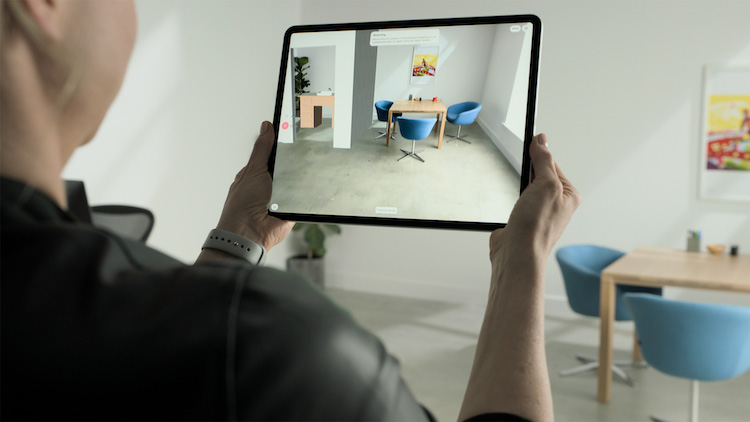Apple’s new iPad Pro sports LiDAR and new chip
Apple’s latest version of its iPad Pro tablet computer integrates technology more commonly found in robots and autonomous cars – LiDAR.
LiDAR, short for Light Detection and Ranging, refers to a type of sensor which gives the device information about objects around it and the distance to them.
Apple says it decided to put LiDAR in the new iPad Pro to give the camera in the device a greater sense of depth.
In a press release, Apple says the new iPad Pro adds an Ultra Wide camera, studio-quality mics and a “breakthrough” LiDAR Scanner all designed to deliver “cutting-edge depth-sensing capabilities”, opening up more pro workflows and supporting pro photo and video apps.
Apple says the LiDAR Scanner enables capabilities “never before possible on any mobile device”. The LiDAR Scanner measures the distance to surrounding objects up to five meters away, works both indoors and outdoors, and operates “at the photon level at nano-second speeds”.

New depth frameworks in iPadOS combine depth points measured by the LiDAR Scanner, data from both cameras and motion sensors, and is enhanced by computer vision algorithms on Apple’s new A12Z Bionic for a more detailed understanding of a scene.
Apple says the tight integration of these elements enables a whole new class of augmented reality experiences on iPad Pro.
Apple consistently uses advanced technologies in its devices which it often designs and develops itself, and this is the first time it is using LiDAR.
It’s not immediately clear from media reports who is supplying the underlying LiDAR technology, but it looks like Apple has used different components from different suppliers – including Sony, Texas Instruments, Himax and Lumentum – and manufactured its own “LiDAR Scanner”, as it calls it. (More details on EE Times and i-MicroNews.com.)
Reuters reported last year that Apple considers the technology to be a very important component for its devices.
One of those devices was, at the time, thought to be a driverless car, which Apple has been rumoured to be developing for some time, under the project title Titan.
However, not much more information has emerged about the fabled Apple car.
By integrating the LiDAR Scanner, pro cameras, motion sensors, pro performance, pro audio, the Liquid Retina display and “powerful apps”, Apple says it has extended the lead of iPad Pro as “the world’s best device for augmented reality”.
Augmented reality is another of Apple’s priorities, but it requires vast computing resources, both on the device and in the cloud.
Apple’s cloud infrastructure is probably not as extensive and as powerful as that of rivals such as Google or Amazon, but it is said to be working on it.
However, Apple has been investing heavily in developing its own microprocessors, perhaps preferring to try and keep data processing “on the edge”, as they call it, or on the device as much as possible.
The new iPad Pro is built on Apple’s new “A12Z Bionic chip”, a microprocessor specially designed for artificial intelligence.
Apple says the A12Z Bionic chip is “built for the most demanding tasks”, such as AR, editing 4K video, or designing 3D models.
The company claims that the available computing power in the new iPad Pro make it “more powerful than most Windows PC laptops”.
The eight-core GPU in the A12Z Bionic, along with an enhanced thermal architecture and tuned performance controllers, gives iPad Pro the highest performance ever in an iPad.
Combined with the eight-core CPU and the powerful Neural Engine, which enables next-generation apps, Apple boasts that “there’s no other chip that can offer the incredible performance found in the thin and light design of iPad Pro”.
With longer battery life lasting up to 10 hours, faster Wi-Fi connectivity and gigabit-class LTE, Apple says the new iPad Pro is 60 percent faster, and has support for more LTE bands than any other tablet.
Phil Schiller, Apple’s senior vice president of worldwide marketing, says: “The new iPad Pro introduces advanced technologies never before available in mobile computing.
“Combining the most advanced mobile display with powerful performance, pro cameras, pro audio, the breakthrough LiDAR Scanner and new Magic Keyboard with Trackpad, this is another huge leap forward for iPad.
“There’s no other device in the world like the new iPad Pro and we think our customers are going to love it.”
Craig Federighi, Apple’s senior vice president of software engineering, says: “We’re making iPad even more capable and versatile by bringing trackpad support to iPadOS.
“We carefully considered the best way to integrate trackpad use into a touch-first environment while retaining everything our customers know and love about iPad. We’re thrilled to bring this new way of interacting with iPad to the millions of people using iPadOS today.”

